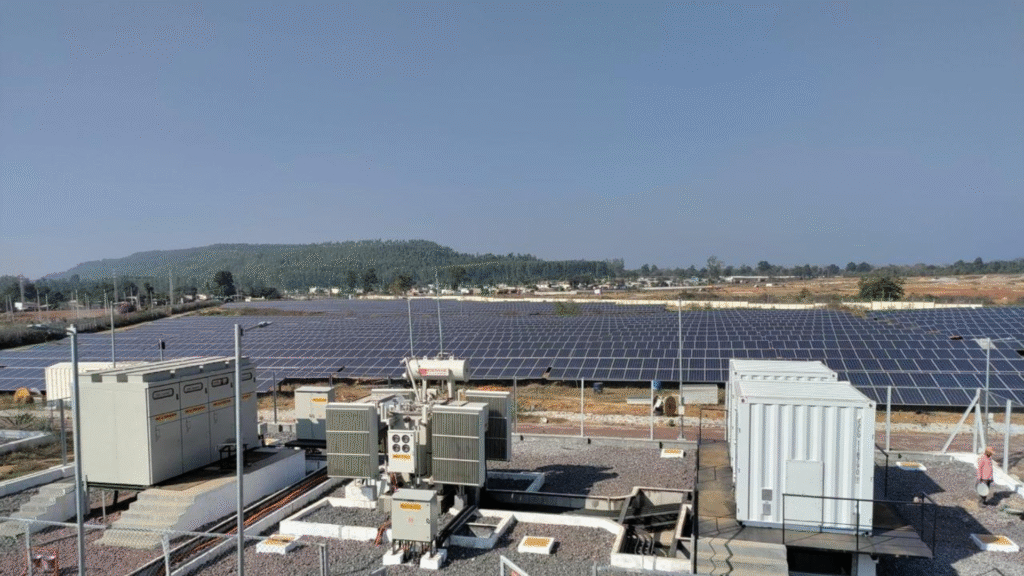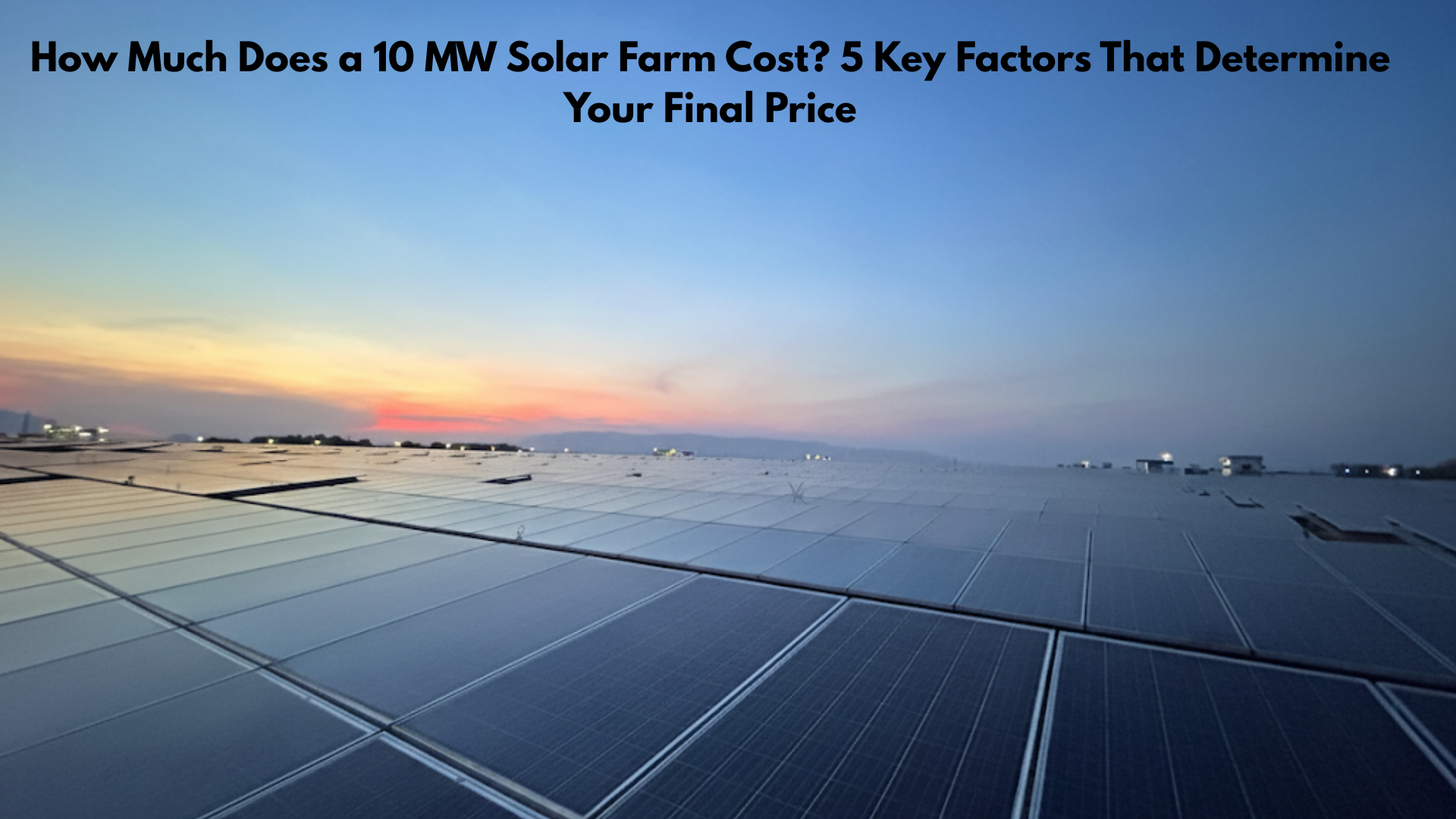Jaipur isn’t just the capital of Rajasthan; it’s the strategic heart of India’s solar revolution. With its high solar irradiance, supportive state policies, and vast stretches of land, the region is a global hotspot for renewable energy investment.But let’s be clear: developing a 50-megawatt (MW) or 100-MW solar farm is not a simple construction project. It’s a high-stakes, multi-year financial and logistical marathon.It’s an undertaking where complex variables—from land titles and grid availability to volatile module prices and intricate state regulations—can make or break a project’s profitability before the first panel is ever installed.This is not a “Do-It-Yourself” venture.This is where the real value of experienced utility-scale solar developers in Jaipur comes to light. An expert partner doesn’t just build your plant; they navigate the labyrinth of policy, secure your assets, and ultimately, guarantee your project’s bankability.
If you are an investor, an Independent Power Producer (IPP), or a large corporation looking to build a utility-scale solar asset in the Jaipur region, this comprehensive A-Z guide will walk you through the entire process.
Phase 1: Feasibility & Site Selection by Leading Utility-scale solar developers in Jaipur

Before a single rupee is spent on hardware, it must be spent on data. The success of a multi-crore project is decided in this initial planning phase.
Site Selection: Why Utility-scale solar developers in Jaipur See More Than Just “Empty Land”
An amateur sees empty land; an expert sees a complex matrix of variables. The “perfect” site is a rare find, and it’s a developer’s job to find the optimal one.
Key criteria include:
- Grid Proximity & Capacity: This is the most critical factor. How far is the nearest high-voltage Grid Sub-Station (GSS)? Is there available capacity (bay) to evacuate the power you generate? A 5 km distance is viable; a 50 km distance can kill the project’s budget.
- Solar Irradiance (DNI): Jaipur and its surrounding areas (like Jodhpur, Jaisalmer, and Bikaner) have some of the highest Direct Normal Irradiance in the world. Your developer will use Pvsyst software to create a highly accurate energy yield simulation.
- Land Characteristics: Is the land flat? Is it agricultural land that requires complex conversion? Is it rocky, increasing civil work costs? A geotechnical survey is essential.
- Accessibility: Can 40-foot trailers and heavy cranes reach the site? Lack of a simple access road can add months and crores to your budget.
The Detailed Project Report (DPR): Your Project’s Bible
Once a site is shortlisted, the developer creates a bankable Detailed Project Report (DPR). This is the document that investors and banks will scrutinize. It’s a cold, hard analysis, not a sales pitch, containing:
- Detailed site analysis and Pvsyst-based energy yield simulations.
- Technology selection (e.g., Mono-PERC vs. Bifacial modules, central vs. string inverters, fixed-tilt vs. trackers).
- Complete project design, from Single Line Diagrams (SLDs) to the civil work blueprints.
- A precise financial model, including LCOE (Levelized Cost of Energy), ROI (Return on Investment), and Payback Period.
Phase 2: Land Acquisition & Approvals by Utility-scale solar developers in Jaipur

This is where most solar projects fail.
Hardware is easy to buy. Navigating the maze of Indian bureaucracy, state-level policies, and local land laws is an art form. This phase separates professional utility-scale solar developers in Jaipur from everyone else.
Land Acquisition: The Make-or-Break Hurdle
You cannot build on a handshake. Your developer must secure clean, legally indisputable land. This involves:
- Due Diligence: A 30+ year title search to ensure there are no hidden claims.
- Lease vs. Buy: Most developers prefer a 30-35 year land lease model to keep CAPEX down.
- Land Conversion (NA): In Rajasthan, most land is agricultural. It must be legally converted to “Non-Agricultural” (NA) status for industrial use—a complex process.
Liasoning: The Unspoken Value of a Local Developer
A developer based in Delhi or Mumbai simply cannot compete with a Jaipur-based team. Securing approvals is a full-time job of follow-up and relationship management.
A partial list of key approvals includes:
- RRECL (Rajasthan Renewable Energy Corporation Ltd.): The nodal agency for all renewable projects.
- DISCOM (JVVNL, AVVNL, or JdVVNL): The local utility for grid connection and the Power Purchase Agreement (PPA).
- RVPML (Rajasthan Rajya Vidyut Prasaran Nigam Ltd.): For high-voltage transmission lines.
- State Environmental Clearance (SEIAA).
- Local Panchayat, Collectorate, and Revenue Department NOCs.
A good developer doesn’t just file applications; they navigate them, saving you months of costly delays.
Phase 3: Securing the Investment – Financial Closure

With a bankable DPR and key land/grid approvals in hand, your project is now “investment-ready.” Your developer will help you achieve financial closure.
This is where you finalize your business model. The two most common options are CAPEX and OPEX (RESCO).
CAPEX vs. OPEX: A Quick Comparison
| Feature | CAPEX Model (You Buy) | OPEX / RESCO Model (You Lease) |
| Ownership | You own the solar asset 100%. | The developer (or investor) owns the asset. |
| Upfront Cost | High (You pay the full project cost). | Zero or Very Low. |
| Primary Benefit | All energy savings/revenue is yours. | Fixed, low electricity cost via a PPA. |
| O&M | You are responsible (or must hire a firm). | The developer handles all O&M. |
| Best For | IPPs, companies with capital, long-term asset builders. | Companies wanting to save cash and avoid risk. |
Phase 4: Boots on the Ground – The EPC Process

This is the phase everyone visualizes. Now that the paperwork is done, the actual build-out, known as EPC (Engineering, Procurement, and Construction), begins.
Engineering
This is the “brain” of the operation. The engineering team finalizes every single design component, ensuring the plant is optimized for the specific site conditions.
Procurement
Here, a large developer’s scale is a massive advantage. They have strong purchasing power with Tier-1 manufacturers of:
- Solar Modules (e.g., Trina, Jinko, Adani, Waaree)
- Inverters (e.g., SMA, Hitachi, Sungrow)
- Mounting Structures & Trackers (e.g., Arctech, Nextracker)
Construction
This is a massive logistical operation managed by the project team:
- Civil Work: Land leveling, grading, and foundation work (piling or ballasts).
- Mechanical Installation: Assembling the thousands of mounting structures.
- Module Installation: The physical (and careful) mounting of tens of thousands of solar panels.
- Electrical Work: Building the inverter stations, switchyards, and running kilometers of DC and AC cabling.
- Grid Interconnection: Building the final transmission line to the GSS.
Phase 5: Commissioning & O&M by Utility-scale solar developers in Jaipur

The project isn’t finished when the last panel is installed. It’s finished when it’s safely delivering power to the grid.
Commissioning
This is a rigorous testing phase where every component is checked and certified. DISCOM and RRECL officials will conduct their own inspections before giving the final “charging permission.” Once this is granted, your plant is officially “commissioned” and begins generating revenue.
Operations & Maintenance (O&M)
A solar plant is a 25-year asset. It is not a “fit-and-forget” technology. To ensure your plant generates the exact amount of power predicted in your financial model, it requires constant, professional O&M.
Any reputable developer will also offer a long-term O&M contract, including:
- 24/7 Remote Monitoring from a central control room.
- Preventive Maintenance: Regular inverter servicing, cable health checks.
- Corrective Maintenance: A rapid-response team to fix any breakdowns.
- Panel Cleaning: In a dusty environment like Rajasthan, robotic cleaning is essential to prevent generation losses.
Frequently Asked Questions (FAQ)
1. Why is Jaipur so good for utility-scale solar projects?
Jaipur is at the center of Rajasthan, which has the highest solar irradiance in India. It also has a strong state-level solar policy, a well-developed grid infrastructure (GSS), and nodal agencies like RRECL specifically designed to support developers.
2. What is the typical cost per MW for a utility-scale solar project in Rajasthan?
The cost can vary significantly based on technology (e.g., trackers vs. fixed-tilt), module prices, and land costs. As of 2025, you can expect it to be in the range of ₹3.5 to ₹4.5 Crore per MW. A good developer will provide a detailed, transparent quote in your DPR.
3. How long does it take to develop a 100MW solar project?
From initial site survey to commissioning, a 100MW project can take anywhere from 18 to 24 months. The construction (EPC) phase may only be 6-8 months, but the land acquisition and liasoning (approvals) phase is what takes the most time.
4. What is the main role of RRECL in my project?
RRECL (Rajasthan Renewable Energy Corporation Ltd.) is the state’s nodal agency. You will interact with them for everything from initial project registration and land allocation (if using government land) to final commissioning approval. They are the central authority for implementing Rajasthan’s solar policy.
5. What makes your company different from other utility-scale solar developers in Jaipur?
While many companies can build a plant, we specialize in the two most critical parts: liasoning and long-term O&M. Our Jaipur-based team has a proven track record of navigating complex approvals with RRECL and DISCOMs, ensuring your project doesn’t get stuck in files. Furthermore, our 25-year O&M plans use predictive analytics and robotic cleaning to guarantee your asset’s performance.
Conclusion: Your Vision, Our Execution. Why Your Developer is Your Most Critical Asset.
As you can see, building a utility-scale solar project in Jaipur is one of the most complex and rewarding ventures in modern infrastructure.
The technology is the “easy” part. The real challenge—and the real value—lies in the orchestration.
It’s about orchestrating land deals, state policies, global supply chains, financial stakeholders, and construction teams.
Ready to build your solar legacy in Rajasthan?
If you are looking for utility-scale solar developers in Jaipur with a proven track record, deep local expertise, and an end-to-end EPC and O&M solution, our team is ready to talk.

